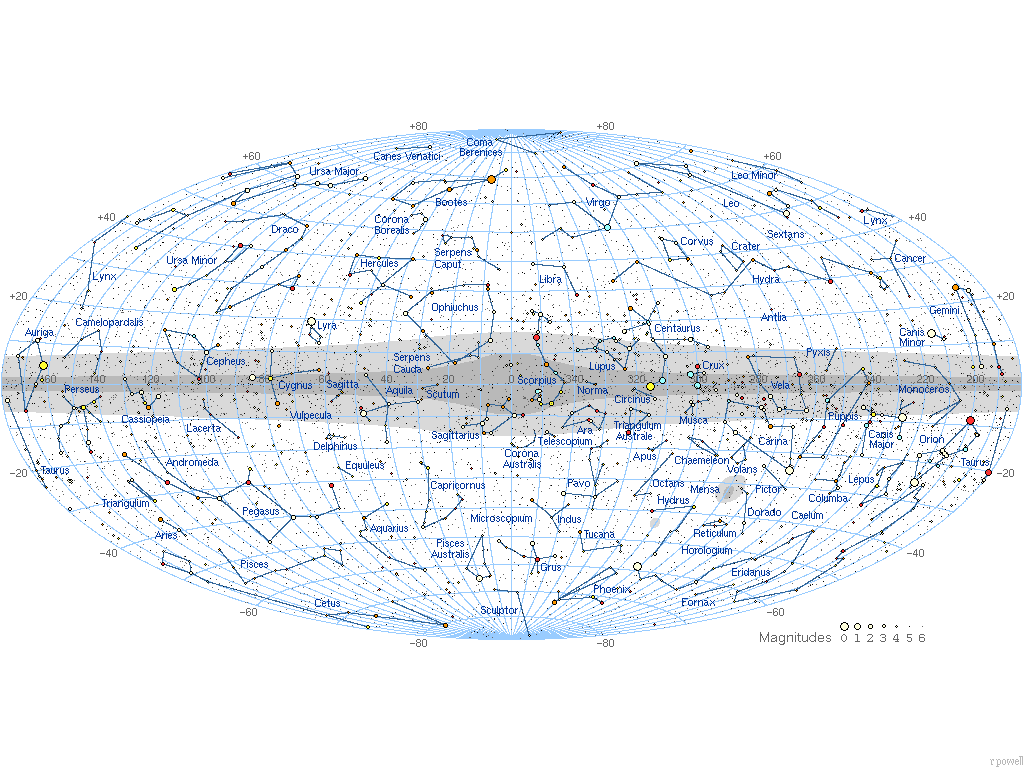Constellations
I thought I would present the images I have taken sorted by two categories. One possible categoy would be sorting images by what constellation they are found in. Originally a constellation was an asterism (pattern of stars). However, modern usage defines a constellation as a specific area of the celestial sphere surrounding an asterism. So in other words, any position in the celestial spehre can be unambiguously assigned to a constellation. There are 88 constellations. Originally, 48 of these constellations were listed by Ptolemy in his Almagest in the 2nd century (based on the ancient Babylonians and Greeks). Another 40 were added in the "modern" era by by Petrus Plancius (1592 to 1613), Johannes Hevelius (1690) and Nicolas Louis de Lacaille (1763). Out of the 88 modern constellations, 36 lie predominantly in the northern sky, and the other 52 predominantly in the southern sky.
This map is plotted in galactic coordinates coordinate system. The galactic coordinate system disregards celestial equators and celestial poles.
The center line of the Milky Way determines the galactic equator.
The galactic longitude of a star is defined as the angle between the baseline of the center of the Galaxy and the Sun and the line between the star and the Sun. The galactic longitude l is measured in degrees (0° to 360).
The galactic latitude b (0° to +-90°) represents the angle between the line of sight from the Sun to the star and the galactic plane.
The Sun revolves about the Center of the Galaxy in clockwise direction given the Galactic North Pole as a viewpoint. The period of the sun's revolution is about 240 million years.
Galactic map courtesy of Richard Powell

Deep Space Object Categories
Open Star Clusters
An open cluster (or galactic cluster) is a group of up to a few thousand stars that were formed from the same gas cloud Stars form when some sort of shock wave passes through, compressing the clouds such that they collapse and form stars. Over time these stars may wander away from each other, but depending on many factors, for a time they stay together in a group. Open clusters are generally found in a galaxy's rim.
Globular Clusters
These star clusters are much larger clusters of hundreds of thousands of stars that are drawn together into a concentrated, spherical shape than the open clusters. Globular clusters are found in the halo of a galaxy and are much older than the less dense open clusters. Globular clusters may form when two galaxies collide which stimulates star formation on much larger scales.
Diffuse Nebulae
Diffuse Nebulae are created by clouds of interstellar gas and dust. Most of this gas is dark, but when a bright, hot star is nearby it can glow. There are two ways for the gas to glow giving rise to two classes od diffuse nebulae. In those cases where the energy of a nearby star can ionize nearby gas, emission nebulae are formed. Energy absorbed by atoms such as hydrogen causes electrons to be move up to a more nergetic orbital. When these atoms returnn back to their ground state, light is emitted at longer wavelenths. Reflection nebulae are clouds of interstellar gas/dust which reflect the light of a nearby star or stars. The energy from the nearby stars is insufficient to ionize the gas of the nebula to create an emission nebula, but is enough to give sufficient scattering to make the dust visible. Thus, the frequency spectrum shown by reflection nebulae is similar to that of the illuminating stars.
Dark Nebulae
A dark nebula or absorption nebula is a type of interstellar cloud of sub-micrometre-sized dust particles that is so dense it obscures the light from objects behind it. Their shape is very irregular with no clearly defined outer boundaries and sometimes take on convoluted serpentine shapes. The largest dark nebulae are visible to the naked eye, appearing as dark patches against the brighter background of the Milky Way like the Coalsack Nebula and the Great rift.
Planetary Nebulae
The term "planetary nebula" is a misnomer that originated with William Herschel because when viewed through his telescope, they appeared to resemble the rounded shapes of planets. Planetary nebulae occur at the end of the lives of intermediate and low mass stars between 0.8 to 8.0 solar masses. After most of the hydrogen in a star has been converted to helium by fusion, the core of the star contracts. This contraction compresses the core and raises its temperture. The higher core temperature makes the stars cooler outter layers expand to create a "red giant". During this phase, the outer layers of the star are expelled by strong stellar winds. After most of the red giant's atmosphere is dissipated, the core emits ultraviolet radiation ionizes the shell of nebulous gas around the central star appearing as a bright coloured planetary nebula at several discrete visible wavelengths. Planetary nebulae are thus also emmision nebulae.
Supernova Remnants
Stars greater than 8 solar masses usually end their lives in dramatic supernovae explosion. Supernovae can be triggered in one of two ways: by the sudden re-ignition of nuclear fusion in a white dwarf (Type I) or by the gravitational collapse of the core of a massive star (Type II). In the first case, a white dwarf may accumulate sufficient material from a companion, either through accretion or via a merger, to raise its core temperature, ignite carbon fusion, and trigger runaway nuclear fusion, completely disrupting the star. In the second case, the core of a massive star may undergo sudden gravitational collapse, releasing gravitational potential energy to create a supernova explosion.
Galaxies
A galaxy is a gravitationally bound system of stars, stellar remnants, interstellar gas and dust, and dark matter. Galaxies range in size from dwarfs with just a few thousand stars to giants with one hundred trillion stars.
Galaxy Groups
Not surpisingly, these are clusters of galaxies.
